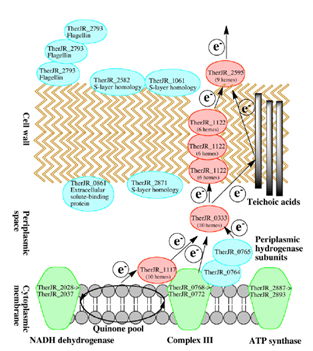Thermincola potens JR
Recently, a Gram positive bacterium was identified as the dominant organism in the anode of a MFC operated at 55 ºC. This organism, Thermincola potens JR, does not excrete soluble redox mediators and requires direct contact with the solid substrate for electron transfer to occur. The genome of T. potens JR was sequenced and showed the presence of 33 putative multiheme cytochromes. Spectroscopic data show that some of these cytochromes participate in the reduction of insoluble hydrous ferric oxide, and contact the surface of electrodes.
Some cytochromes were already assigned to the bioenergetic electron transfer chain that links the metabolism of T. potens JR to the cell surface. These are TherJR_1117, a putative quinol oxidoreductase associated to the cytoplasmic membrane, TherJR_0333 is a soluble cytochrome from the periplasmic space between the membrane and the cell wall, and TherJR_1122 and TherJR_2595 are cytochromes attached to the cell wall. These proteins were cloned in E. coli opening the pioneering opportunity of a detailed biochemical characterization of the molecular components of dissimilarity metal respiration by Gram positive bacteria. This group aims to characterize the cytochromes of T. potens JR
Some cytochromes were already assigned to the bioenergetic electron transfer chain that links the metabolism of T. potens JR to the cell surface. These are TherJR_1117, a putative quinol oxidoreductase associated to the cytoplasmic membrane, TherJR_0333 is a soluble cytochrome from the periplasmic space between the membrane and the cell wall, and TherJR_1122 and TherJR_2595 are cytochromes attached to the cell wall. These proteins were cloned in E. coli opening the pioneering opportunity of a detailed biochemical characterization of the molecular components of dissimilarity metal respiration by Gram positive bacteria. This group aims to characterize the cytochromes of T. potens JR

From Carlson et al (2012) PNAS






